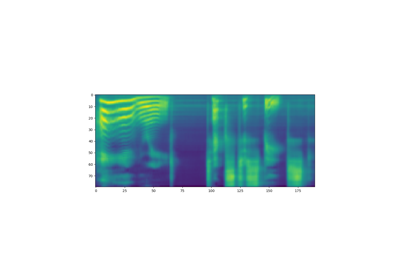WaveRNN
- class torchaudio.models.WaveRNN(upsample_scales: List[int], n_classes: int, hop_length: int, n_res_block: int = 10, n_rnn: int = 512, n_fc: int = 512, kernel_size: int = 5, n_freq: int = 128, n_hidden: int = 128, n_output: int = 128)[source]
WaveRNN model from Efficient Neural Audio Synthesis [Kalchbrenner et al., 2018] based on the implementation from fatchord/WaveRNN.
The original implementation was introduced in Efficient Neural Audio Synthesis [Kalchbrenner et al., 2018]. The input channels of waveform and spectrogram have to be 1. The product of upsample_scales must equal hop_length.
See also
torchaudio.pipelines.Tacotron2TTSBundle: TTS pipeline with pretrained model.
- Parameters:
upsample_scales – the list of upsample scales.
n_classes – the number of output classes.
hop_length – the number of samples between the starts of consecutive frames.
n_res_block – the number of ResBlock in stack. (Default:
10)n_rnn – the dimension of RNN layer. (Default:
512)n_fc – the dimension of fully connected layer. (Default:
512)kernel_size – the number of kernel size in the first Conv1d layer. (Default:
5)n_freq – the number of bins in a spectrogram. (Default:
128)n_hidden – the number of hidden dimensions of resblock. (Default:
128)n_output – the number of output dimensions of melresnet. (Default:
128)
- Example
>>> wavernn = WaveRNN(upsample_scales=[5,5,8], n_classes=512, hop_length=200) >>> waveform, sample_rate = torchaudio.load(file) >>> # waveform shape: (n_batch, n_channel, (n_time - kernel_size + 1) * hop_length) >>> specgram = MelSpectrogram(sample_rate)(waveform) # shape: (n_batch, n_channel, n_freq, n_time) >>> output = wavernn(waveform, specgram) >>> # output shape: (n_batch, n_channel, (n_time - kernel_size + 1) * hop_length, n_classes)
- Tutorials using
WaveRNN:
forward
- WaveRNN.forward(waveform: Tensor, specgram: Tensor) Tensor[source]
Pass the input through the WaveRNN model.
- Parameters:
waveform – the input waveform to the WaveRNN layer (n_batch, 1, (n_time - kernel_size + 1) * hop_length)
specgram – the input spectrogram to the WaveRNN layer (n_batch, 1, n_freq, n_time)
- Returns:
shape (n_batch, 1, (n_time - kernel_size + 1) * hop_length, n_classes)
- Return type:
Tensor
infer
- WaveRNN.infer(specgram: Tensor, lengths: Optional[Tensor] = None) Tuple[Tensor, Optional[Tensor]][source]
Inference method of WaveRNN.
This function currently only supports multinomial sampling, which assumes the network is trained on cross entropy loss.
- Parameters:
specgram (Tensor) – Batch of spectrograms. Shape: (n_batch, n_freq, n_time).
lengths (Tensor or None, optional) – Indicates the valid length of each audio in the batch. Shape: (batch, ). When the
specgramcontains spectrograms with different durations, by providinglengthsargument, the model will compute the corresponding valid output lengths. IfNone, it is assumed that all the audio inwaveformshave valid length. Default:None.
- Returns:
- Tensor
The inferred waveform of size (n_batch, 1, n_time). 1 stands for a single channel.
- Tensor or None
If
lengthsargument was provided, a Tensor of shape (batch, ) is returned. It indicates the valid length in time axis of the output Tensor.
- Return type:
(Tensor, Optional[Tensor])

